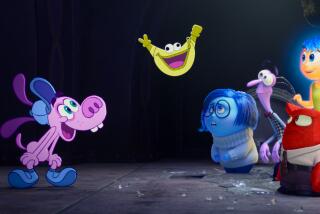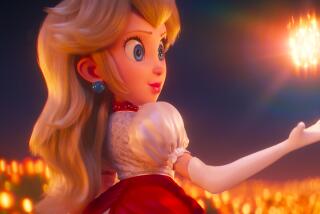‘Detective Pikachu’ director on how they made those realistic Pokémon
- Share via
It wasn’t easy bringing the Pokémon in “Detective Pikachu” to life.
A hybrid live-action/computer animation film, “Pokémon Detective Pikachu” took the box office by storm last weekend and follows Tim Goodman (played by Justice Smith) and a talking Pikachu with amnesia (voiced by Ryan Reynolds) as they try to solve the mystery around the disappearance of Tim’s father, Harry.
Based on the “Pokémon” spin-off video game “Detective Pikachu,” the Warner Bros./Legendary film takes the “Pocket Monsters” that were originally designed in 2-D for the franchise’s many games and transforms them into realistic 3-D creatures that look good enough to touch.
“We carefully crafted the Pokémon into the real world so that they looked like living, breathing creatures and also the Pokémon that everyone has grown up on and knows so well,” said “Pokémon Detective Pikachu” director Rob Letterman in a recent interview. “We worked very closely with the Pokémon Company.”
Letterman met with the original creators, artists and game designers in Tokyo before the company that oversees everything “Pokémon” created a team to work with the film crew and provide feedback and notes. Many people were involved in the yearlong collaboration to get the looks just right.
“We had to figure out a way to stay true to [the] Pokémon characters for the hardcore fans,” said Letterman.
Their approach to making the 3-D Pokémon believable involved taking the original 2-D character designs, staying true to each silhouette, and adding photo-real textures. In addition to creating texture guides for the Pokémon, the artists studied how various animals actually moved to make everything as realistic as possible.
Besides the Pokémon that appear in the “Detective Pikachu” video game, Letterman specifically wanted the Pokémon introduced in the original ’90s Game Boy game to be represented in the movie.
“We wanted the first-generation Pokémon in there because there’s so much nostalgia from the people who are in their 20s and early 30s,” said Letterman about the 151 Pokémon introduced in “Pokémon Red” and “Blue.” “We wanted to tie into that feeling of the Pokémon that they grew up on.”
Here’s what Letterman had to say about some specific Pokémon that appear in “Detective Pikachu.”
Pikachu
Pikachu may be the most recognizable Pokémon of the franchise, but talking Pokémon are mostly unheard of.
As the core characters of the movie, Pikachu and Tim share plenty of scenes. But Letterman explained that the logistics of shooting their scenes were “beyond complicated.”
“We had Ryan for the first four days [of shooting] for the kind of pivotal relationship scenes,” said Letterman. He would be off screen while “Justice would look at an eye line that wasn’t Ryan and would act to a puppet or a tennis ball or a marker or nothing.”
In addition to voicing the character, Reynolds performed Pikachu’s expressions through facial motion capture. And it was during this stage of production that the tables were turned.
“Later, it was Ryan’s turn to perform against nothing in the craziest places on Earth,” said Letterman. “He was on a Michael Bay movie [so] the visual effects supervisor and I would get on a plane like a mobile documentary crew with a microphone and this crazy head camera, facial capture rig and fly halfway across the world, jump in a van and find Ryan, who would just email me a Google map with a red pin dropped.”
The nontalking voice of Pikachu was provided by Japanese actress Ikue Ôtani, who voices the Pikachu that appears in the long-running “Pokémon” anime series.
Aipom
Early on in the film, Tim is attacked by a pack of rampaging Aipom while in his father’s apartment. Shooting the scene involved Smith fighting off creatures that didn’t exist.
“The stunt team had rehearsed all that with Justice,” said Letterman, who explained that Smith was on cables and getting yanked around while having to perform as if there were actual things on him.
“We wanted real tactile weight distribution on his body so he was getting tugged by wires and his shoulders were being pushed down and at the same time he had to act to a little Pikachu that wasn’t there,” the director added.
Mr. Mime

Watch the first trailer for “Pokémon Detective Pikachu.”
Letterman explained that because of the complexity of the visual effects, there aren’t any animated Pokémon that ended up on the cutting room floor. However, a certain interrogation scene involving Tim, Pikachu and Mr. Mime came close.
“Justice walks onto the set and the only thing there for him is a stool and a lamp and that’s it,” Letterman said. “[He was] acting with a Mime that wasn’t there and a Pikachu that wasn’t there. It was crazy. I distinctly remember looking at him as we’re shooting and going ‘this is never going to work.’”
Which was ironic because Letterman was the one who originally fought to get the scene into the movie. He even had to present the idea to the president of the Pokémon Co. for approval because others thought the scene would be impossible.
“I remember getting blank stares,” said Letterman, adding that he used visuals from the 1995 movie “Seven” to help convey that he was envisioning a police interrogation scene.
Thankfully, the film’s producers convinced Letterman to keep the scene despite his doubts.
Psyduck
Letterman shared that the Pokémon he identified with the most is Psyduck, Lucy Stevens’ (Kathryn Newton) duck-like partner Pokémon who suffers from dangerously explosive headaches.
“I think anyone who’s a writer at some point will relate to Psyduck and that sort of stressed out vibe that it has,” said Letterman. “I think it’s just a really cool character and I’m glad we got Psyduck in there. It was a big favorite on the crew as well.”
Jigglypuff
A Jigglypuff makes a cameo in “Detective Pikachu,” singing on a table at the Hi-Hat Café. It was a familiar sight for fans of the “Pokémon” anime, where a traveling Jigglypuff, who is an aspiring singer, continually gets upset when people keep falling asleep during its performances due to the special power of its song.
Letterman revealed that he had a personal reason for making sure the cute, round Pokémon appeared the movie.
“Jigglypuff is my daughter’s favorite so we snuck Jigglypuff in,” said Letterman.
Mewtwo
The Mewtwo story line is directly adapted from the “Detective Pikachu” game, and Letterman was thrilled to be working with the character for the movie.
“Mewtwo is my son’s favorite,” said Letterman. “It’s such a cool and classic Pokémon. ‘Pokémon: The First Movie: Mewtwo Strikes Back’ was the one I first saw with my kids so it was especially great to have [the character] in [‘Detective Pikachu’].”
Gotta spot ‘em all: Where to see six more Pokémon in ‘Detective Pikachu’
Cubone
Early in the film, Tim tries to catch a Cubone, a Pokémon known for being a bit lonely. Officially, the skull a Cubone wears as a mask is that of its dead mother.
Lickitung
Tim has a slightly gross encounter with a Lickitung on his way to Ryme City. It’s said that Lickitung’s tongue is about twice as long as its body.
Snubbull
Lt. Yoshida’s (Ken Watanabe) partner Pokémon is a Snubbull. Despite its scary face, Snubbull are said to be a bit timid but affectionate.
Ludicolo
The Ludicolo that works at the Hi-Hat Café is another Pokémon that originally appeared in the “Detective Pikachu” video game. Ludicolo are known to get more active when they hear festive music, but the movie doesn’t show its reaction to Jigglypuff’s song.
Bulbasaur
Bulbasaur helped out Tim and Pikachu when they were in trouble. In the original “Pokémon” game, Bulbasaur is one of the three Pokémon a player can choose to start their journey as a Pokémon Trainer.
Greninja
Tim, Pikachu, Lucy and Psyduck were chased by some Greninja (they look like they’re wearing scarves but those are actually their tongues). Greninja are the final evolved form of Froakie, the frog-like starter Pokémon from “Pokémon X” and “Y.”
Twitter: @tracycbrown
More to Read
The biggest entertainment stories
Get our big stories about Hollywood, film, television, music, arts, culture and more right in your inbox as soon as they publish.
You may occasionally receive promotional content from the Los Angeles Times.











